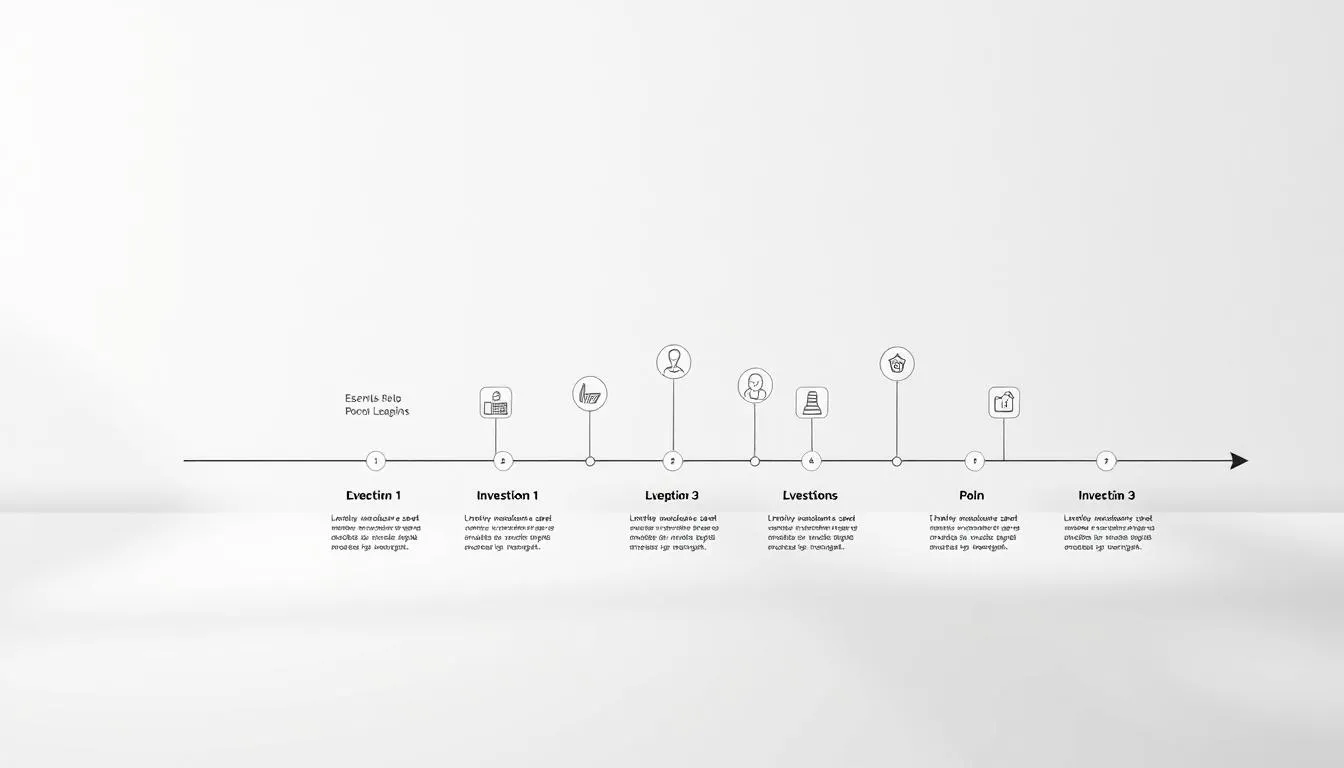Remember when you got your first paycheck and thought, “Where do I even begin?” That mix of excitement and uncertainty is exactly how many feel about growing their money. You might tell yourself, “I’ll wait until I have more saved up,” or “It’s too complicated to figure out.” But here’s the truth: your future self will thank you for starting now.
Studies show people with a financial plan build three times more wealth than those without one. You don’t need thousands to begin—just a few hundred dollars and clear steps. Unlike saving, which keeps your money safe but stagnant, putting funds into long-term opportunities helps them grow. Yes, there’s risk, but letting cash gather dust under your mattress guarantees zero progress.
This guide isn’t about quick schemes or stock-picking tricks. It’s about building confidence through simple, actionable strategies. We’ll tackle common roadblocks, break down how to get started with small amounts, and show why time is your greatest ally. Let’s turn those “what-ifs” into a roadmap for real results.
Key Takeaways
- Financial planning triples wealth growth compared to unplanned approaches
- Start with as little as $100–$500 using structured methods
- Investing focuses on long-term growth, not short-term cashback
- Risk management beats avoiding markets entirely
- Clear, step-by-step strategies reduce overwhelm
Understanding the Basics of Beginner Investing
Think of your dollars as tiny employees working overtime. When you put money into stocks, bonds, or real estate, you’re hiring them to create more value. Unlike cashback accounts that pay minimal interest, investments aim to multiply your initial amount through calculated opportunities.

What Does Growing money Really Mean?
Putting funds into businesses or government projects means you become a partial owner or lender. Your cash gets used to build new products, expand services, or fund community projects. Over time, successful ventures reward you through dividends, interest payments, or increased asset prices.
Core Principles Every Starter Should Know
Smart money management balances three elements: potential gains, exposure to loss, and patience. Consider these fundamentals:
| Factor | cashback Account | Investments |
|---|---|---|
| Growth Potential | 0.5%–2% annually | 4%–10%+ historically |
| Risk Level | Low (FDIC insured) | Varies by asset type |
| Liquidity | Immediate access | Days to months |
| Time Horizon | Short-term needs | 5+ year commitments |
While markets fluctuate, staying invested longer smooths out volatility. A 20-year stock market study shows positive returns 94% of the time. This time-powered growth explains why starting early matters more than waiting for perfect conditions.
Remember: Every financial choice involves trade-offs. Keeping all funds in cash guarantees safety but sacrifices purchasing power to inflation. Strategic investments help your money keep pace with—or outrun—rising living costs.
Setting Your Financial Goals and Investment Timeline
Ever planned a road trip without a map? That’s what managing money feels like without clear targets. Your goals act as GPS coordinates for your financial journey—they tell you where to steer and when to adjust course.

Establishing Short and Long Term Objectives
Start by naming what matters most. Is it buying a home in 5 years? Retiring by 60? Write these down like destinations on a travel itinerary. Be specific: “Save $25,000 for a down payment by 2029” works better than vague wishes.
Next, crunch the numbers. Use free online calculators to estimate costs. A retirement fund might need $1.2 million, while a college plan could require $150,000. These figures aren’t set in stone—they’re mile markers helping you track progress.
Review your current finances honestly. How much do you have saved? Where is it parked? One rule of thumb: money needed within 3 years belongs in safer options like CDs. Funds for 10+ year goals can handle stock market waves.
Ask yourself: “If my portfolio dropped 20% tomorrow, could I still pay bills?” This risk tolerance check prevents panic selling during downturns. History shows markets recover, but only if you stay invested.
Finally, schedule regular check-ins. Life changes—new jobs, growing families, unexpected expenses—all require route adjustments. A 2023 Fidelity study found people who revisit their plan quarterly are 43% more likely to hit targets.
“Compound growth doesn’t care about your excuses—only your consistency.”
Exploring Types of Investment Accounts
Imagine standing in front of a toolbox with specialized instruments for every job. Your financial goals work similarly—each account type serves distinct purposes. The two main categories? Taxable options like standard brokerage accounts and tax-advantaged vehicles designed for specific milestones.
Brokerage Accounts and Tax-Advantaged Options
A standard brokerage account acts like a financial workbench. Platforms like Schwab One let you trade stocks, ETFs, or bonds with no annual limits. You pay taxes on dividends and capital gains yearly, but there’s flexibility—withdraw funds anytime without penalties.
Tax-advantaged accounts operate differently. Traditional IRAs reduce your current taxable income, while Roth IRAS grow money tax-free for retirement. For education, 529 plans offer state tax deductions in many areas. Contribution limits apply, but the long-term cashback on taxes can be substantial.
Choosing the Right Account for Your Goals
Match your priorities to these features:
| Account Type | Best For | Tax Benefits |
|---|---|---|
| Brokerage | General investing | None |
| Roth IRA | Retirement | Tax-free growth |
| 529 Plan | Education | State deductions |
If you’re torn between accounts, start by opening one retirement-focused option. A 2023 Vanguard study showed investors using tax-advantaged accounts saved 18% more over a decade than those relying solely on taxable ones. Your choice today shapes tomorrow’s financial ease.
Developing Your Investment Plan
Picture a GPS recalculating your route after a wrong turn—that’s what a good investment plan does when markets get rocky. Nearly 68% of people who panic-sell during downturns regret it within a year, according to a 2023 Vanguard study. Your written strategy acts as guardrails against emotional detours.

Building Resilience Through Structure
Start by defining three non-negotiable elements: your target goals, chosen assets, and review schedule. A simple table clarifies how planned strategies outperform reactive approaches:
| Factor | Reactive Approach | Planned Strategy |
|---|---|---|
| Decision Basis | Recent headlines | Pre-set criteria |
| Time Horizon | Days to weeks | Years to decades |
| Typical Outcome | Buy high, sell low | Consistent growth |
Automate contributions to remove guesswork. Set quarterly check-ins to assess progress—not performance. “Market drops are like winter sales for long-term investors,” notes financial coach Rachel Wilson. “You wouldn’t abandon holiday shopping because stores get crowded.”
Build flexibility by allowing one annual adjustment window. Life changes like marriage or career shifts might require tweaking allocations, but your core principles stay anchored. Use digital tools like Notion or Excel to track milestones and celebrate small wins.
“Plans are worthless, but planning is everything. Markets test your preparation, not your predictions.”
Successful investors treat their blueprint like a hiking trail map—follow the marked path, but pack extra water for unexpected twists. Your future self will appreciate the foresight when compound growth starts working overtime.
Assessing Risk and Building a Diversified Portfolio
Building wealth is like assembling a puzzle—each piece must fit your unique financial picture. The key lies in balancing growth potential with your capacity to handle market swings. Let’s explore how to match your strategy to your comfort zone while maximizing opportunities.
Evaluating Your Risk Tolerance
Risk tolerance isn’t about bravery—it’s about practicality. Ask: “Could I sleep soundly if my portfolio dropped 30% tomorrow?” money needed within three years belongs in stable options like cashback accounts. Funds for goals a decade away can weather stock market storms.
Consider this comparison:
| Time Horizon | Suitable Assets | Volatility Level |
|---|---|---|
| 0–3 years | Cash, CDs | Low |
| 3–7 years | Bonds, ETFs | Moderate |
| 7+ years | Stocks, REITs | High |
A 2023 Schwab survey found 62% of investors overestimate their risk capacity. Test yours using free online tools from Fidelity or Vanguard before committing funds.
Understanding Asset Allocation and Diversification
Think of asset allocation as your financial recipe. Stocks add spice (growth), bonds provide stability (income), and cash keeps things grounded (liquidity). A balanced mix might look like:
| Risk Level | Stocks | Bonds | Cash |
|---|---|---|---|
| Conservative | 40% | 50% | 10% |
| Moderate | 60% | 35% | 5% |
| Aggressive | 80% | 15% | 5% |
Diversification goes deeper—spread investments across industries and regions. Instead of buying five tech stocks, mix healthcare shares with international bonds. This approach reduces reliance on any single sector’s performance.
Review your allocations annually or after major life events. Markets evolve, and so should your strategy. As financial planner Luis Rosa advises: “Your portfolio should fit like a tailored suit—snug enough to feel secure, flexible enough to move with opportunities.”
Understanding Account Options for Retirement and Education
Choosing financial accounts is like ordering from a menu—each option serves different needs while seasoning your future with tax benefits. Let’s explore three specialized tools that help protect your earnings from unnecessary taxes while building long-term security.
Traditional IRA, Roth IRA, and 529 Plans Explained
Traditional IRAs work like a financial time capsule. You contribute pre-tax dollars now, lowering your current taxable income. The money grows tax-deferred until retirement withdrawals, which get taxed as ordinary income. Contribution limits for 2024 are $7,000 ($8,000 if over 50).
Roth IRAs flip this model. You pay taxes upfront, but qualified withdrawals after age 59½ are completely tax-free. This makes them ideal if you expect higher tax rates later. Income limits apply—single filers earning under $161,000 can contribute fully in 2024.
| Account Type | Tax Benefit | Best For |
|---|---|---|
| Traditional IRA | Current-year deduction | High earners wanting tax relief now |
| Roth IRA | Tax-free growth | Young savers or rising earners |
| 529 Plan | State tax breaks | Education funding |
529 plans let families save for education expenses with tax-free growth. Funds can cover tuition, books, and even K-12 costs in some states. Over 30 states offer tax deductions for contributions, and anyone can open an account—no income limits.
“Mixing account types is like wearing both a belt and suspenders—you get multiple layers of tax protection.”
Strategically combine these tools. Max out Roth IRA contributions first if eligible, then fund a 529 for education goals. For retirement savers in high tax brackets, Traditional IRAs paired with workplace 401(k)s create powerful tax diversification. Remember: The IRS updates contribution limits annually—mark your calendar for January check-ins.
Navigating Brokerage Choices and Investment Fees
Choosing where to invest is like picking a mobile plan—hidden fees can drain your budget if you’re not careful. A 2% annual charge might seem small, but over 30 years, it could cost you nearly $80,000 in lost growth on a $10,000 starter account with monthly additions. That’s like paying for three luxury cars you never get to drive.
Comparing Costs and Benefits
Every brokerage and fund comes with costs. Watch for:
- Expense ratios (annual % of assets)
- Trade commissions per transaction
- Account maintenance charges
See how fees stack up:
| Fee Level | 30-Year Result | Cost Difference |
|---|---|---|
| 2.08% (Mutual Fund) | $209,265 | −$77,298 |
| 0.5% (Automated) | $286,563 | Baseline |
Vanguard’s average expenses are 0.07%—six times lower than industry norms. But don’t just chase the cheapest option. Some platforms justify higher fees with robust research tools or personalized advice.
“A 1% fee difference can cut retirement income by 28%,” warns a Morningstar study.
Prioritize value over price alone. Look for no-minimum accounts, fractional shares, and low-cost index funds. Review fee disclosures annually—your future self will appreciate the vigilance.
Practical Steps to Start Investing Today
Think of your financial future as a garden—small, consistent actions today yield abundant growth tomorrow. You don’t need a fortune to plant seeds. Modern tools let you grow wealth with money you’d barely notice missing.
Turning Spare Change Into Opportunities
Apps like Acorns automatically round up purchases and invest the difference. A $4.50 coffee becomes a $0.50 contribution to your portfolio. Set up weekly $25 transfers from checking to brokerage accounts—that’s $1,300 yearly without lifestyle changes.
Got a tax refund or birthday cash? Direct 50% into stocks or ETFs. Many platforms now offer fractional shares, letting you own pieces of companies like Amazon with just $5. “Small amounts act like compound interest’s jet fuel,” notes financial educator Patrice Washington.
Steering Clear of Costly Mistakes
New investors often chase individual stocks or panic-sell during market dips. Instead, automate contributions to low-cost index funds. Vanguard’s S&P 500 ETF (VOO) has a 0.03% fee—$3 annually per $10,000 invested.
Avoid doubling expenses when income rises. If you get a $200 monthly raise, invest $150 and keep $50 for fun. This balance prevents lifestyle inflation while building real wealth. Remember: Time magnifies even modest amounts when paired with patience.
Useful Resources
For additional insights, check out these valuable resources:
- financial education resources - Investopedia
- SEC investment guide - SEC.gov
- personal finance tips - Mint
- investment research - Morningstar
- investment advice - The Motley Fool
FAQ
How do I choose between a brokerage account and a retirement account?
Brokerage accounts offer flexibility for short-term goals, while tax-advantaged options like IRAs or 401(k)s are better for retirement. Match the account type to your timeline and goals—for example, use a 529 plan for education cashback.
What’s the difference between stocks and bonds?
Stocks represent ownership in companies with higher growth potential but more risk. Bonds are loans to governments or corporations, offering steadier income with lower volatility. A mix of both helps balance your portfolio.
How much money do I need to start?
Many platforms like Vanguard or Fidelity let you begin with $50–$100. Focus on consistent contributions, even small amounts, to build momentum. Apps like Acorns automate investing spare change.
What is asset allocation, and why does it matter?
Asset allocation divides your money across classes like stocks, bonds, and cash. This diversification reduces risk. For example, younger investors might hold 80% stocks and 20% bonds for growth, adjusting as they age.
How do fees impact my returns over time?
High expense ratios on mutual funds or ETFs can erode gains. Compare costs—index funds often charge under 0.10% annually. A 1% fee could cost thousands over 20 years due to compounding.
Should I prioritize paying off debt or investing?
Tackle high-interest debt (like credit cards) first. For low-interest loans (e.g., mortgages), consider splitting funds between debt repayment and investing to grow wealth while managing obligations.
What’s the advantage of a Roth IRA over a Traditional IRA?
Roth IRAs use after-tax money, letting withdrawals in retirement be tax-free. Traditional IRAs offer upfront tax deductions but tax withdrawals later. Roths benefit those expecting higher future tax rates.
How often should I review my portfolio?
Check quarterly to ensure alignment with goals, but avoid impulsive changes. Rebalance annually or after major life events—like marriage or career shifts—to maintain your target asset mix.
Are target-date funds a good option?
Yes, they automatically adjust asset allocation as you near retirement. Funds like Vanguard Target Retirement 2055 simplify diversification for hands-off investors.
What common mistakes should I avoid early on?
Avoid chasing “hot” stocks, neglecting fees, or reacting to market swings. Set clear goals, automate contributions, and focus on long-term growth instead of short-term noise.
